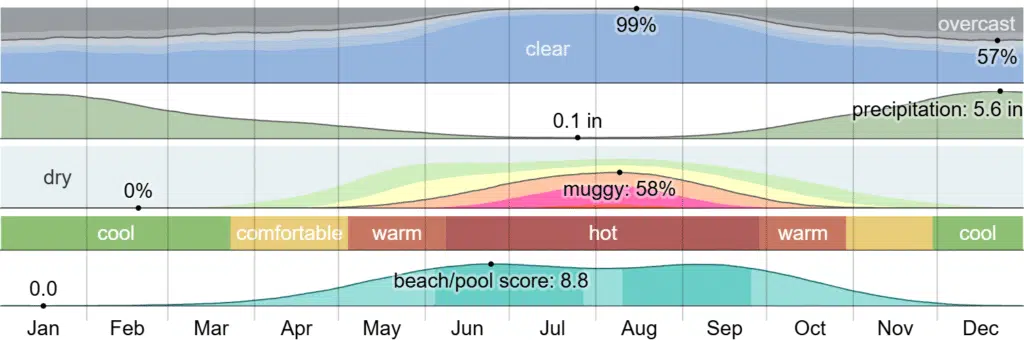The best time to visit Antalya, Turkey, is during spring or autumn. These seasons offer mild weather, allowing you to enjoy both summer attractions and the city’s beautiful beaches. If you’re a beach enthusiast, consider visiting during the first two weeks of September.




Temperatures:
Antalya experiences extreme seasonal variation in monthly rainfall. The rainy period of the year lasts for 8.9 months, from September 12 to June 8, with a sliding 31-day rainfall of at least 0.5 inches. The month with the most rain in Antalya is December, with an average rainfall of 5.5 inches. The month with the fewest wet days is August, with an average of 0.7 days of precipitation.

Based on annual weather averages for Antalya, the best month to go for holiday is April and May. The temperature hovers around 17°c.
The table below displays max and min temperature and rain data for the whole year as an average taken from last 12+ years of historical data for Antalya.
- January: Min 8°C, Max 14°C
- February: Min 9°C, Max 15°C
- March: Min 10°C, Max 17°C
- April: Min 13°C, Max 21°C
- May: Min 17°C, Max 26°C
- June: Min 21°C, Max 30°C
- July: Min 25°C, Max 34°C
- August: Min 25°C, Max 34°C
- September: Min 22°C, Max 31°C
- October: Min 18°C, Max 26°C
- November: Min 13°C, Max 21°C
- December: Min 10°C, Max 16°C
Storms and Gales:
Storm Calendar Overview
- The “Storm Calendar” is a traditional guide, also known as the “old woman’s calendar,” used for predicting seasonal storms based on observations.
- It’s maintained with a margin of error of 1 or 2 days and is crucial for navigators, including fishermen, boat captains, and maritime officers.
Importance for Mariners
- The calendar is specific to Turkey’s coasts and territorial waters, derived from years of observation and experience.
- Despite advancements in satellite weather reporting systems, the Storm Calendar remains a valuable reference tool.
- It is considered the primary source for tracking Turkey’s weather conditions and storms.
Annual Storm Table
- Lists specific dates associated with expected storms throughout the year, such as:
- January:
- January 2: Storm (3 days)
- January 8: Start of Zemheri Storm (Severe winter conditions)
- January 12: Storm (2 days)
- January 14: Karancalos Storm (Winter genie)
- January 17: Storm (2 days)
- January 23: Storm
- January 25: Winter Intensity Storm
- January 28: Ayandon Storm (2 days) (Located in Hamamlı Köyü, formerly known as Sinop’s Ayancık district, an old port where ships couldn’t dock due to stormy conditions in the 1800s)
- January 30: End of Zemheri
- January 31: Fish Storm (Date when fish migrate from the Black Sea to the Sea of Marmara)
- February:
- February 1: Hamsi Storm (Period when anchovies are abundant and mature)
- February 4: Storm (3 days)
- February 10: Storm (3 days)
- February 13: Storm
- February 20: First Cemre (Air)
- February 23: Storm (2 days)
- February 27: Second Cemre (Water)
- March:
- March 1: Storm
- March 6: Third Cemre (Earth)
- March 11: Start of Berdül’aczin, Kocakarı Cold (Cold that affects mainly the elderly and causes bone discomfort)
- March 12: Hüsun Storm (Gentle in nature)
- March 15: Storm
- March 17: End of Bardül’aczin
- March 23: Koz Kavuran Storm (2 days) (Strong southwesterly wind affecting the western part of the Aegean and Marmara)
- March 26: Çaylak Storm (Precursor storm at the end or beginning of winter)
- March 29: Storm
- March 30: Storm (Second of the three nines)
- April:
- April 8: Kırlangıç Storm (2 days) (Time when swallows arrive in Anatolia)
- April 9: Storm (Third of the three nines)
- April 11: Storm (2 days)
- April 16: Kuğu(Swan) Storm (One of the severe storms)
- April 21: Start of Sitte-i Sevr (Period when the Sun enters the Taurus constellation)
- April 26: End of Sitte-i Sevr
- April 29: Storm
- May:
- May 4: Çiçek Storm (Period when plants bloom)
- May 7: Storm (2 days, period of east winds)
- May 11: Unseasonal cold (3 days)
- May 17: Filizkıran Storm (Approximately 8 intensity storm breaking plant buds)
- May 19: Kokulya Storm (2 days) (Time for silkworm cocoon spinning)
- May 21: Ülker Storm (Pleiades Constellation)
- May 30: Kabak Meltemi (2 days) (Start of summer heat)
- June:
- June 2: Storm
- June 3: Filiz Koparan Storm (Approximately 8 intensity storm)
- June 10: Ülker Doğumu Storm (3 days, when Pleiades is visible in the Taurus constellation)
- June 22: Gün Dönümü Storm (Summer solstice, farthest point of the Sun from Earth)
- June 27: Kızıl Erik Storm (2 days, flowering period for European plum)
- July:
- July 1: Yaprak Storm (Period when all plants have leaves)
- July 3: Sam Yelleri (Hot winds)
- July 6: Storm (2 days)
- July 9: Çark Dönümü Storm (3 days)
- July 10: End of Bevarih winds (Severe heat and winds)
- July 11: Storm (2 days)
- July 16: Storm (2 days)
- July 18: Increase in heat
- July 20: Gün Dönümü Storm (Summer solstice, farthest point of the Sun from Earth)
- July 25: Storm (2 days)
- July 30: Kızıl Erik Storm (Fruit-bearing period for European plum)
- August:
- August 3: Birthday Storm (Period of increased births in the Marmara region)
- August 14: Storm
- August 17: Storm
- August 19: Storm
- August 20: Storm (2 days)
- August 23: End of Sam winds (Hot winds)
- September:
- September 2: Mihrican Storm (Beginning of autumn)
- September 7: Bıldırcın Geçimi Storm (Migration of quails to the Black Sea with the Poyraz winds)
- September 13: Çaylak Storm (Precursor storm at the end or beginning of winter)
- September 19: Storm
- September 25: Storm
- September 28: Kestane Karası Storm (Period of abundant fish in the Marmara)
- September 30: Turna Geçimi Storm (Migration of cranes)
- October:
- October 3: Kuş Geçimi Storm (Migration period for the last birds in Anatolia)
- October 4: Koç Katımı Storm (Time when separated rams are returned to the flock)
- October 9: Yaprak Dökümü Storm (Period when nature sheds leaves in preparation for winter)
- October 14: Meryem ana (Mother Mary) Storm (Thunderstorms with rain)
- October 17: Kırlangıç Storm (Migration of swallows from Anatolia)
- October 18: Koz Kavuran Storm (Lodos wind affecting the western part of the Aegean and Marmara)
- October 21: Bağ Bozumu Storm (Grapes harvested from vineyards)
- October 28: Balık Storm (Fish migration from the Sea of Marmara to the Black Sea)
- November:
- November 2: Kuş Geçimi Storm (Migration period for the remaining birds in Anatolia)
- November 7: Kasım Storm
- November 11: Unseasonal Heat
- November 12: Lodos Storm (Southwestern Wind)
- November 17: Koç Katımı Storm (Time when separated rams are returned to the flock)
- November 28: Storm
- December:
- December 2: Ülker Dönümü Storm (End of Pleiades’s presence in the Taurus constellation)
- December 4: Storm (2 days)
- December 6: Northern Winds
- December 6: Zemheri Storm (Severe winter conditions)
- December 9: Karakış Storm (2 days)
- December 19: Storm
- December 21: Gün Dönümü Storm (Winter solstice, farthest point of the Sun from Earth)
